Arranging funeral flowers is a decision which can be influenced by your family's expectations and preferences, the costs involved, your own taste and what you think your loved one would have wanted.
Knowing the different types of flowers available, how much you can expect to spend and the symbolism behind different flowers can help.
If choosing funeral flowers is adding to the pressure of making funeral arrangements, you may prefer to choose simpler floral arrangements or decide against having funeral flowers altogether.
Traditional funeral flowers are available in several different popular arrangement styles.
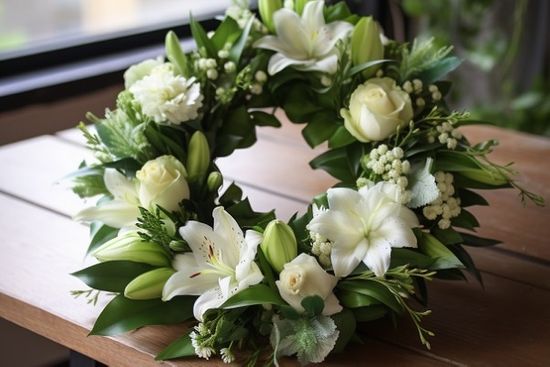
This “O” shaped circle of flowers is an arrangement commonly placed on top of the coffin.
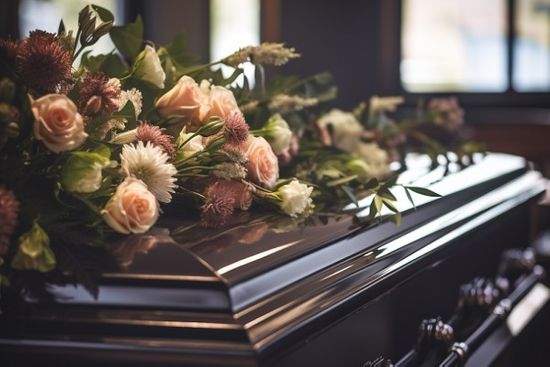
This larger teardrop or diamond-shaped floral arrangement is designed to lie flat on top of the coffin.

A hand-tied bouquet with visible stems offers a smaller and more rustic arrangement for the top of the coffin.
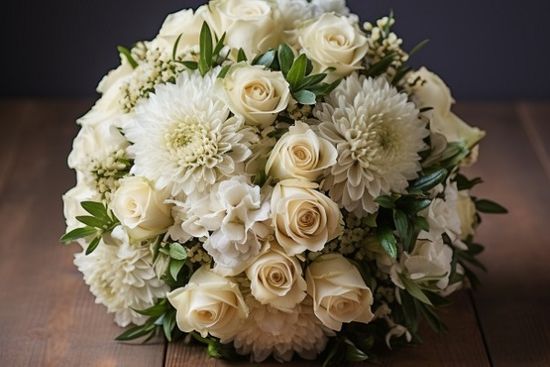
This small round floral arrangement can be placed on top of the coffin or on a table or windowsill at the funeral.
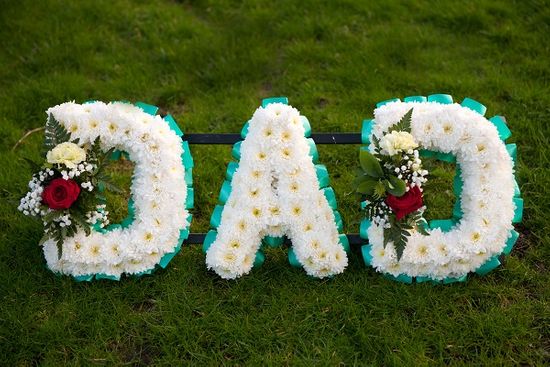
Letters spelling out the deceased’s name or family relationship are commonly displayed in funeral cars.
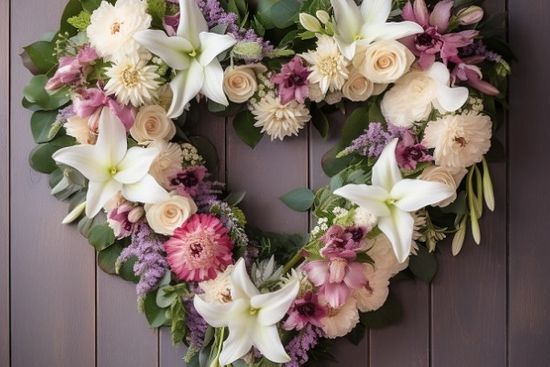
A heart-shaped wreath is another popular design for funeral flowers due to its association with love.
Uniquely shaped floral tributes can be arranged to be displayed on or next to the coffin or in the funeral chapel.
Popular shapes include:
The coffin can also be adorned with a garland which is a long floral arrangement designed to encircle the outside edges.
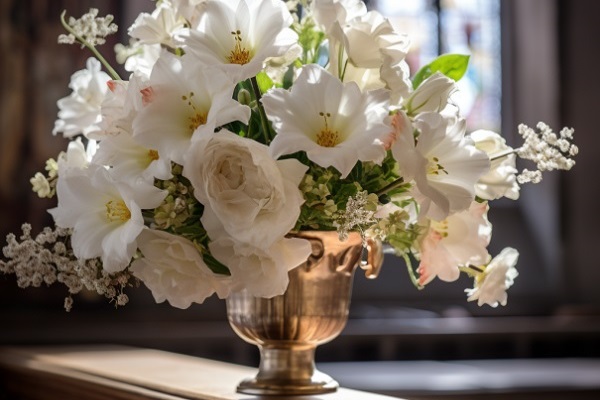
There is no right or wrong when it comes to arranging funeral flowers. Keeping your loved one in mind whilst you make your selection may help to make the funeral choices easier.
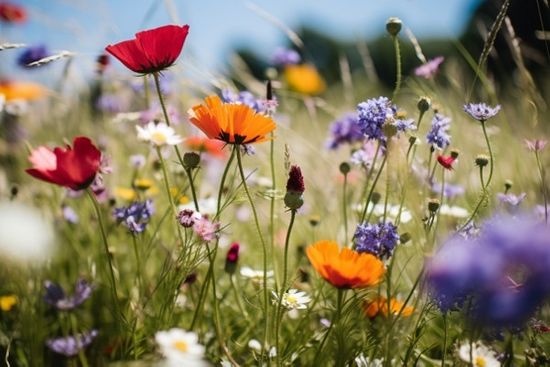
There are many ways to reflect your loved one's personality in your choice of flowers.

White is the most traditional colour for funeral flowers, but the flowers can be any colour that suits your loved one.
Head of Grounds, Westerleigh Group
"The traditional funeral flowers on the coffin or decorating the chapel are not the only flowers found at our crematoriums. We want families attending a funeral or paying their respects at a loved one’s grave to experience the peacefulness and beauty of nature from the moment they enter our grounds.
“Colourful floral beds, blooming rose gardens, spring primroses and wildflower meadows at our crematoriums provide a haven for bees and other wildlife. I’m always really impressed with the horticultural improvements our grounds teams carry out and their dedication to creating a welcoming natural environment."
As well as choosing flowers for their appearance, you may also like to consider flowers with different symbolic meanings in your floral displays.
| Type of funeral flowers | Symbolism |
|---|---|
| Forget me nots | As the name suggests, the forget me not is commonly associated with memory and can symbolise always keeping memories of your loved one with you. |
| Roses | The rose is the flower most widely associated with love and is beautiful in many colours from red and pink to yellow and white. |
| Poppies | The poppy is a flower with strong associations of remembrance and could be especially fitting for someone who served in the armed forces. |
| Lillies | Common in funeral flower arrangements, the lily is a symbol of death and grief but also purity, rebirth and hope. |
| Tulips | The tulip and other spring flowers can be associated with renewal and new beginnings. Tulips are also symbolic of unconditional and enduring love. |
| Sunflowers | The cheery yellow of a sunflower and the way sunflowers turn towards the sun associates them with brightness, positivity and warmth. |
| Carnations | Like roses, carnations are also said to symbolise all kinds of deep love from the love felt between romantic partners to loving familial bonds. |
When arranging funeral flowers, checking whether your loved one shared their funeral wishes before they died, for example in their will, can help you plan a funeral service with their choices in mind.
People spent on average £222 on funeral flowers in 2024. Some factors that influence the price of funeral flowers are:
* The average spend on funeral flowers in 2024 was £222. (SunLife Cost of Dying Report 2025, sunlife.co.uk/funeral-costs)
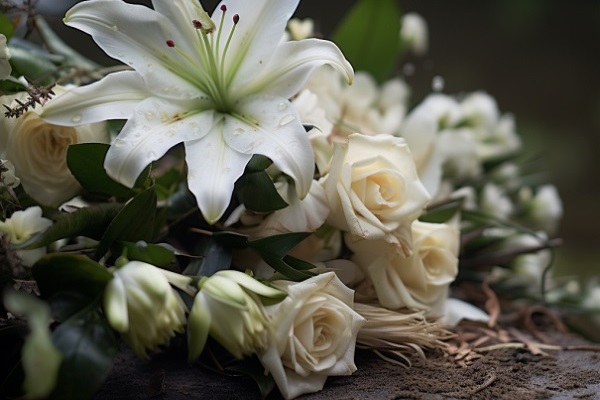
Condolence bouquets or sympathy flowers are traditionally given to the immediate family of the person who has died to express sympathy, support and well wishes.
The person making arrangements may request funeral donations to charity in the deceased's name instead of flowers so it's best to check beforehand.
How to send sympathy flowers
Arranging sympathy flowers to be sent directly to a bereaved person's home is more convenient for them than bringing flowers to the funeral. You can order the flowers online or give the address to your local florist.
What to write on funeral flowers
Kind words from the heart or simple expressions of support like "thinking of you", "truly sorry for your loss" or "our deepest and most heartfelt condolences" can bring comfort.
Do you write the person's name on funeral flowers?
You can address the flowers to the bereaved recipient or directly to your lost loved one. You can also include both names by expressing your sympathies and including a message directly to your loved one as well.
Should funeral flowers be in a vase?
Some condolence bouquets will come in a vase, but others may come in a basket or a box. A longer-lasting alternative to funeral flowers you could consider is a living flowering plant in a pot.
Should you throw flowers on a coffin?
Throwing flowers or dirt onto a coffin has the symbolic significance of returning a loved one to the earth. This is traditionally done at a burial funeral. You can follow the lead of the chief mourners and throw a flower or handful of earth onto the coffin if you are invited to.
You can arrange a completely unattended direct cremation instead. Having an unattended funeral gives you time to arrange a separate end-of-life event free from tradition wherever and whenever you want.
Choosing an alternative way to remember your loved one lets you celebrate their life more personally.
Arrange a funeralStill have questions about arranging funeral flowers? These frequently asked questions may help you answer them.

It's usually the person organising the funeral service who pays for the funeral flowers. If you are concerned about affording flowers, you can ask friends or family for support or simplify arrangements with a low cost funeral.
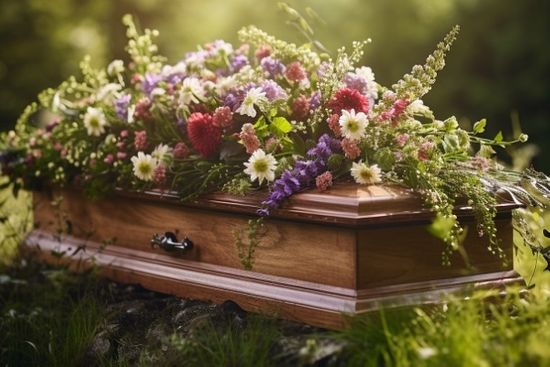
What you do with the flowers after the funeral is your own choice. You can leave the floral arrangements at the burial ground or crematorium. Or if you prefer, you can take the flowers home or gift them to family or friends.

Funeral flowers are conventionally placed on top of the coffin at the head rather than at the feet or where the coffin is widest. Some larger floral arrangements and sprays may cover the majority of the coffin's lid.

Arranging funeral flowers yourself could save you money but may add to the stress of planning. You will need to check how long the flowers you want will last and prepare them last minute to make sure they’re fresh.
For support arranging a dignified and inexpensive cremation funeral, call our customer service specialists on 01543 212000 or see our guidance about other aspects of the funeral service.

We provide all of our own cremation services, supporting you with the necessary paperwork, facilitating a respectful cremation and personally returning your loved one's ashes.
Arrange a funeral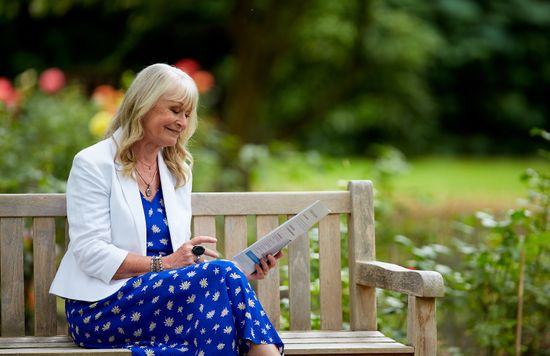
Whilst planning a funeral service you may make some choices about your own wishes. A cremation plan with Distinct Cremations lets you choose your own funeral in advance.
View funeral plans
If you've chosen a cremation for your loved one's funeral, depending on your plans for their ashes you may need an urn or other ashes container designed for burial or scattering.
Funeral urns guideWe offer the highest level of support, but don't just take our word for it. Below are recent reviews from customers who bought a funeral with us.





